Corporate human resources
You also want an ePaper? Increase the reach of your titles
YUMPU automatically turns print PDFs into web optimized ePapers that Google loves.
<strong>Corporate</strong> <strong>human</strong> <strong>resources</strong><br />
Managing your HR legal risks –<br />
common liability issues and how<br />
to avoid them<br />
Presented by: Jeff Mitchell and Chelsea Rasmussen<br />
November 30, 2016<br />
1<br />
Avoiding common employer liabilities<br />
and HR risks<br />
1. Best practices when drafting incentive plans<br />
2. Required compliance updates to your HR policies<br />
3. Recent employment cases of interest<br />
4. Managing your exposure in wrongful dismissal and <strong>human</strong> rights<br />
claims<br />
29 November 2016 2
1. Best practices when drafting<br />
incentive plans<br />
29 November 2016 3<br />
Overview<br />
• Employee contracts and bonus plans often include language that<br />
requires an employee to be “actively employed” at the time a bonus is<br />
paid in order for the employee to receive any payments under the bonus<br />
plan<br />
• When an employee is given notice of termination and receives pay in lieu<br />
of termination notice, employers often take the position that the<br />
employee is not “actively employed” during the termination notice period<br />
• The question is whether an employee is entitled to receive a bonus that<br />
the employee would have otherwise received during the termination<br />
notice period if the employment contract or bonus plan requires the<br />
employee to be “actively employed”?<br />
29 November 2016 4
The last word on the meaning of “actively<br />
employed”: Paquette v TeraGo Networks Inc., 2016<br />
ONCA 618<br />
• Mr. Paquette’s employment was terminated without cause in November<br />
2014<br />
• The reasonable notice period was held to be 17 months (November 25,<br />
2014 to April 25, 2016)<br />
• His bonus plan provided that an employee “actively employed by [the<br />
employer] on the date of the bonus payout” was eligible for a bonus<br />
• Bonuses were paid annually in February<br />
• Mr. Paquette claimed damages for lost bonus payments during the<br />
notice period<br />
• At trial, the Ontario Superior Court rejected Paquette’s claim for<br />
damages for lost bonus payments, holding that he would not be an<br />
“active employee” during the notice period<br />
29 November 2016 5<br />
Paquette v TeraGo Networks Inc., cont’d<br />
• On appeal, the Ontario Court of Appeal articulated a two part test:<br />
1. Consider the employee’s common law entitlement<br />
2. Determine whether there is something in the bonus plan that would<br />
specifically remove the entitlement to a bonus<br />
• “The question…was not whether the bonus plan was ambiguous, but<br />
whether the wording of the plan…was effective to limit his right to receive<br />
compensation for lost salary and bonus during the period of reasonable<br />
notice”<br />
• Based on the language of the bonus plan, the Ontario Court of Appeal<br />
awarded Mr. Paquette damages for the loss of his bonus in 2014 and the<br />
lost opportunity to earn a bonus in 2015<br />
• The Court used a three year average of the bonuses the employee<br />
received before 2014 to assess the bonus amount in 2014-2015<br />
29 November 2016 6
Practical considerations in light of Paquette<br />
• The Court in Paquette left the door open for well drafted employment<br />
contracts and bonus plans to disentitle employees to bonuses during the<br />
notice period<br />
• If an employer wants to restrict an employee’s entitlement to a bonus<br />
during the notice period, the employment contract or bonus plan should<br />
include unambiguous and specific limiting language<br />
• If the bonus is discretionary, it should be expressed as such rather than<br />
appearing as an integral part of the employee’s compensation package<br />
• Refer to “eligibility to participate”, not entitlement<br />
• Provide the ability of the employer to discontinue or amend the terms of<br />
the bonus plan, either in the employment contract or the bonus plan<br />
• Be careful to ensure the employment contract does not contradict the<br />
text of the bonus plan!<br />
29 November 2016 7<br />
Practical considerations in light of Paquette, cont’d.<br />
• Any bonus plan limitations or conditions on the payment of the bonus<br />
must be brought to the employee’s attention<br />
• A requirement for “active employment” can still be used for a bonus plan,<br />
but should be defined (i.e. not payable upon resignation, termination for<br />
cause)<br />
• When defining period of “active employment” following a without cause<br />
termination, you must include the period of statutory notice of termination<br />
(if any) required by the Employment Standards Act, 2000, but you can<br />
exclude the common law notice period for purposes of the definition<br />
• State that a bonus is subject to required deductions and withholdings<br />
and is not vested or earned until paid<br />
29 November 2016 8
2. Required compliance updates to<br />
your HR policies<br />
29 November 2016 9<br />
Compliance with Ontario’s new Bill 132<br />
Bill 132 – An Act to amend various statutes with respect to sexual<br />
violence, sexual harassment, domestic violence and related matters<br />
• Introduced in October, 2015<br />
• Received Royal Assent on March 8, 2016: The Sexual Violence and<br />
Harassment Action Plan Act, 2015<br />
• Amends various acts, including the OHSA<br />
• Amendments to the OHSA came into force on September 8, 2016<br />
• Amendments apply to all workplaces of provincially-regulated businesses<br />
in Ontario<br />
29 November 2016 10
Compliance with Ontario’s new Bill 132<br />
A. Update existing policies and programs to include Bill 132’s new<br />
requirements and specifically address “workplace sexual harassment”<br />
B. Provide workers with information and instruction on updated workplace<br />
harassment policies and programs<br />
C. Appropriately investigate all incidents and complaints of workplace<br />
harassment, given that MOL inspectors may now order investigations<br />
regarding workplace harassment<br />
29 November 2016 11<br />
Compliance with Ontario’s new Bill 132<br />
A. Updating workplace harassment policies and programs<br />
Employers must:<br />
• Develop and maintain a written workplace harassment program<br />
• Work in consultation with the joint health and safety committee to<br />
develop and maintain the written Program<br />
• Review the Program as often as necessary, but at least annually<br />
29 November 2016 12
Compliance with Ontario’s new Bill 132<br />
A. Workplace harassment program contents<br />
• New requirements:<br />
• - Alternative reporting procedures for instances in which the alleged<br />
harasser is the worker’s employer or supervisor<br />
• - A process for how incidents or complaints of workplace harassment will be<br />
investigated and dealt with<br />
• - That information obtained about the incident or complaint will not be<br />
disclosed, unless disclosure is necessary to take corrective action, to protect<br />
workers, or because it is otherwise required by law<br />
• - How the results of the investigation, or any corrective action that will be<br />
taken, will be shared with the worker who reported the complaint and the<br />
alleged harasser<br />
• May combine workplace harassment policy with other policies and<br />
programs, such as the workplace violence policy and program or an<br />
anti-harassment or anti-discrimination policy based on the criteria in the<br />
Human Rights Code<br />
29 November 2016 13<br />
Compliance with Ontario’s new Bill 132<br />
B. Providing workers with information and instruction<br />
Employers must provide appropriate information and instruction on the<br />
workplace harassment policy and program:<br />
• Workers should be aware of the policy/program and understand their<br />
contents<br />
• Workers designated to receive complaints of workplace harassment from<br />
workers must understand how to deal with complaint<br />
• Additional information and instruction may be required when a policy or<br />
program is revised<br />
29 November 2016 14
Compliance with Ontario’s new Bill 132<br />
C. Procedure to investigate complaints of workplace sexual harassment<br />
• The OHSA amendments impose positive duties on employers to<br />
protect workers from workplace harassment<br />
• Employers must:<br />
• Conduct “appropriate” investigations into all incidents and complaints of<br />
workplace harassment<br />
• Inform the parties in writing of the results of the investigation and/or of resulting<br />
corrective action<br />
• Review the workplace harassment program as often as necessary, but at least<br />
annually<br />
29 November 2016 15<br />
Compliance with Ontario’s new Bill 132<br />
C. Procedure to investigate complaints of workplace sexual harassment<br />
• What is an “appropriate” investigation?<br />
• Depends on complexity of the matter<br />
• Considerations include whether the employer treated the incident or complaint seriously,<br />
acted promptly, and allowed time and sufficient <strong>resources</strong> to investigate and deal with it<br />
• Complaint and investigation should be properly documented<br />
• Who can conduct an investigation?<br />
• Any neutral party who was not involved in the incident and not under the direct<br />
control of the alleged harasser, including someone:<br />
• In the workplace;<br />
• In the organization;<br />
• Associated with the workplace or organization; or<br />
• From outside the workplace or organization<br />
29 November 2016 16
Compliance with Ontario’s new Bill 132<br />
C. Procedure to investigate complaints of workplace sexual harassment<br />
• There is no deadline for completing an investigation<br />
• Interim measures (such as temporary reassignments or shift changes)<br />
may be necessary<br />
• Results of the investigation must be communicated to the worker who<br />
was allegedly harassed and the harasser (if s/he is a worker of the<br />
employer)<br />
• Note the new enforcement mechanism - MOL inspectors now have<br />
power to:<br />
• Order an employer to arrange for an appropriate investigation to be<br />
conducted by an impartial person who possesses knowledge, experience or<br />
qualifications as specified by the inspector; and<br />
• Obtain, at the employer’s expense, a written report by the impartial person<br />
29 November 2016 17<br />
3. Recent employment cases of<br />
interest<br />
29 November 2016 18
Howard v. Benson Group Inc., 2016 ONCA 256<br />
• Mr. Howard was employed in a management position pursuant to a 5 year, fixed<br />
term agreement<br />
• The agreement provided for early termination in the event of Mr. Howard’s<br />
resignation<br />
• In the event of early termination without cause, the Agreement stated that “…any<br />
amounts paid to the Employee shall be in accordance with the Employment<br />
Standards Act of Ontario”<br />
• Mr. Howard’s employment was terminated and he brought an action for breach of<br />
contract<br />
• He sought damages for remuneration of the balance of his contract which<br />
equated to over three years of salary and benefits<br />
• The employer argued that any damages should be limited to the two weeks that<br />
Mr. Howard was entitled to under the Employment Standards Act<br />
29 November 2016 19<br />
Howard v. Benson Group Inc. cont’d<br />
• First, the Ontario Court of Appeal held that by choosing a fixed-term<br />
arrangement, the parties had “unambiguously ousted” the statutory<br />
reasonable notice period, by providing a clear contractual obligation of a<br />
five year term<br />
• Second, the Court held that employees working under a fixed-term<br />
agreement do not have a duty to mitigate their losses unless the<br />
agreement specifies otherwise<br />
• The Court awarded Mr. Howard the remaining 23 months in his 5 year<br />
term, and did not discount this amount based on his mitigation efforts,<br />
because his agreement did not specify a duty to mitigate<br />
• This case is a key example of the dangers of using fixed term contracts,<br />
and the importance of drafting clear, unambiguous termination provisions<br />
29 November 2016 20
Wilson v. Atomic Energy of Canada Ltd., 2016 SCC<br />
29<br />
• Mr. Wilson, a non-unionized employee, was dismissed without cause by<br />
his federally regulated employer after four and a half years of service<br />
• Mr. Wilson claimed that he had been “unjustly dismissed” contrary to the<br />
Canada Labour Code (the “Code”)<br />
• The employer argued that because it had provided the employee with a<br />
generous severance package well in excess of the minimum statutory<br />
entitlements, the employee had not been unjustly dismissed<br />
• The Federal Court and the Federal Court of Appeal agreed with the<br />
employer, holding that nothing in the Code prevents federally regulated<br />
employers from dismissing non-unionized employees without cause<br />
• The employee appealed to the Supreme Court of Canada<br />
29 November 2016 21<br />
Wilson v. Atomic Energy of Canada Ltd. cont’d<br />
• The Supreme Court of Canada held that the purpose of the Code’s unjust<br />
dismissal scheme is to provide “…a cost-effective alternative to the civil court<br />
system for dismissed employees to obtain meaningful remedies which are far<br />
more expansive than those available at common law.”<br />
• The Court noted that the remedies contemplated by the Code for non-unionized<br />
employees are meant to reflect those generally available in the collective<br />
bargaining context<br />
• Accordingly, the Court overturned the previous decisions, holding that the unjust<br />
dismissal scheme in the Code does not permit federally regulated employers to<br />
dismiss employees without cause after at least one year of service<br />
• Until the Code’s unjust dismissal scheme is amended to allow for without cause<br />
dismissals, federally regulated employers can only dismiss an employee with one<br />
year or more of service due to performance issues, a lack of work or the<br />
discontinuance of a function<br />
29 November 2016 22
Keenan v. Canac Kitchens, 2015 ONSC 1055<br />
• The Plaintiffs, a husband and wife, both worked for the<br />
defendant as employees between 1983 to 1987<br />
• In 1987, the Defendant notified the Plaintiffs that they would no<br />
longer be employees, but instead, would carry on their work as<br />
“independent contractors”<br />
• Plaintiffs became responsible for paying installers but this<br />
payment was funded by the defendant<br />
• The amount the defendant paid to the Plaintiffs was increased to<br />
reflect that their pay was no longer subject to income tax,<br />
Canada Pension Plan and Employment Insurance deductions<br />
• Plaintiffs signed written agreement to confirm terms of new<br />
arrangement<br />
29 November 2016 23<br />
Keenan v. Canac Kitchens, cont’d<br />
• In 2009, Canac closed its operations and informed the plaintiffs<br />
that it no longer required their services<br />
• Plaintiffs argued that they were dependent contractors and were<br />
entitled to reasonable notice at common law<br />
HELD:<br />
• Plaintiffs were dependent contractors<br />
• Court awarded each plaintiff 26 months’ pay in lieu of notice<br />
• Court particularly noted the fact that the business arrangement<br />
was almost exclusively for the Canac’s benefit<br />
29 November 2016 24
Keenan v. Canac Kitchens,<br />
Key take-aways<br />
• “Converting” an employee into an independent contractor should not be<br />
considered an easy means of avoiding liability for common law<br />
reasonable notice<br />
• Not necessarily sufficient protection to have the employee sign a<br />
confirmation or acceptance of independent contractor status – the courts<br />
will look to the specific facts of the case to determine true nature of<br />
relationship<br />
• Trend of reasonable notice “inflation” for dependent contractors – in<br />
some cases, the range of notice being provided is similar to that given to<br />
employees<br />
29 November 2016 25<br />
Computer Enhancement Corporation v. J.C. Options, et<br />
al, 2016 ONSC 452<br />
• Non-Compete Agreement challenged for lack of consideration<br />
• Contract signed after start of employment<br />
• Contract stated that consideration was “each side giving the other<br />
$10.00”<br />
• No evidence of actual payment<br />
• Court: NO valid consideration, particularly given employee’s evidence<br />
that the consideration was never actually paid<br />
• No benefit (e.g. salary increase, bonus, promotion, etc.) in exchange<br />
for signing<br />
• Continued employment generally not “consideration”; must be<br />
something new of value<br />
29 November 2016 26
Computer Enhancement Corporation v. J.C. Options, et<br />
al, cont’d<br />
Second issue: Was the Non-Compete/Non-Solicit Agreement<br />
binding on other brother<br />
• Signed as condition of hiring, so no issue of “consideration”<br />
• Agreement provided for confidentiality, and said that for six months<br />
after employment ended, he would not:<br />
1. Compete in any province in which CEC does business;<br />
2. Intentionally act in a manner that is detrimental to relations between CEC<br />
and its customers, clients, employees…<br />
3. Solicit any customers/clients of CEC, including those in an ongoing<br />
relationship even if business had not yet been conducted.<br />
29 November 2016 27<br />
Computer Enhancement Corporation v. J.C. Options, et<br />
al, cont’d<br />
• Court held the first two provisions were not binding on Jeff, because<br />
they were not “reasonable”:<br />
• “Any province in which CEC does business” is effectively Canada-wide,<br />
which is too broad<br />
• “Intentionally act in any manner that is detrimental to CEC’s relations with<br />
customers” is too vague and ambiguous – no way to know what acts are<br />
precluded<br />
• In context of employment, non-solicit and confidentiality obligations would be<br />
sufficient to protect CEC’s legitimate business interests, and accordingly<br />
non-compete obligations are unnecessary<br />
• The 6-month non-solicit was severable, reasonable and<br />
enforceable<br />
But: did the non-solicit preclude submitting bid in response to<br />
public tender?<br />
29 November 2016 28
Computer Enhancement Corporation v. J.C. Options, et<br />
al, cont’d<br />
• The court recognized that "a bid submitted in response to a public<br />
tender is not a solicitation", and that "responding to a request for<br />
proposals is not sufficient" to establish a breach of a non-solicitation<br />
obligation.<br />
• Important element is that the request for the proposal must come from<br />
the client without any solicitation for that RFP from the entity subject to<br />
the non-solicit.<br />
• Non-solicits generally will not preclude responses to publicly issued<br />
RFPs – need a non-compete for that.<br />
29 November 2016 29<br />
4. Managing your exposure in<br />
wrongful dismissal and <strong>human</strong><br />
rights claims<br />
29 November 2016 30
Types of Damages in employment litigation<br />
• Wrongful dismissal damages<br />
• Aggravated damages<br />
• Punitive damages<br />
29 November 2016 31<br />
Damages – Pate Estate v. Harvey (Township), 2011<br />
ONSC 6620<br />
Facts:<br />
• Plaintiff was Township’s Chief Building Officer from 1989 until 1998<br />
• Township dismissed the Plaintiff on the basis of alleged discrepancies in<br />
building permit fees<br />
• Township never provided the Plaintiff with particulars of the allegations<br />
against him<br />
• Township pressured the OPP to lay criminal charges; Township did not<br />
turn over exculpatory evidence in its possession to the OPP<br />
• Plaintiff ultimately acquitted<br />
• Local media covered the criminal proceedings extensively<br />
• Plaintiff did not obtain employment in the municipal field again and<br />
passed away in January 2011<br />
29 November 2016 32
Damages – Pate Estate v. Harvey (Township), 2011<br />
ONSC 6620<br />
• Trial Judge awarded punitive damages of $550,000.00 (subsequently<br />
reduced to $450,000.00 on appeal)<br />
To date, no evidence has been put before me whereby it would<br />
appear that the municipality has apologised or in any way<br />
accepted responsibility for the conduct of its municipal officer,<br />
nor has it in any way accepted responsibility for the result of<br />
these actions. Indeed, viewed through the eyes of the average<br />
citizen, no doubt they would view the conduct of the municipality<br />
as offensive and morally repugnant.<br />
29 November 2016 33<br />
Costs<br />
• Loser pays system<br />
• Partial Indemnity vs. Substantial Indemnity<br />
• Degree of indemnification has never been precisely defined<br />
• Normal rule is that costs are to be paid on a partial indemnity basis<br />
• Where a party has engaged in conduct that is reprehensible, scandalous or<br />
outrageous there will be grounds for costs to be awarded on a substantial or<br />
complete indemnity basis<br />
• Impact of settlement offers<br />
29 November 2016 34
Costs – Tetra Consulting v. Continental Bank et al.,<br />
2015 ONSC 6546<br />
Facts:<br />
• Tetra began performing service for Continental Bank of Canada and<br />
Continental Currency Exchange Canada lnc.<br />
• Common intention that Tetra’s principal, would become an employee of<br />
the bank once it received regulatory approval<br />
• Before formal employment contract completed, the Bank’s majority<br />
shareholder changed his business plans and the entire venture came to<br />
an end<br />
• Bank terminated its relationship with Tetra and Cassar for cause<br />
• At the commencement of trial, the Bank abandoned allegation of cause<br />
29 November 2016 35<br />
Costs – Tetra Consulting v. Continental Bank et al.,<br />
2015 ONSC 6546<br />
• Judge awarded substantial indemnity costs of $42,394.26<br />
As an aside, I observe that the Bank originally pleaded that Mr.<br />
Cassar was terminated for cause, but has subsequently<br />
abandoned that line of attack. The reason for having abandoned it<br />
is that there is not a stitch of evidence to support it…The pleading<br />
of termination for cause was, as far as I can tell, nothing more<br />
than a cynical tactic deployed by the Bank to discourage this<br />
legal action. Mr. Cassar’s termination by the Bank was entirely<br />
unrelated to his performance.<br />
29 November 2016 36
Costs – Tossonian v. Cynphany Diamonds,<br />
2015 ONSC 766<br />
Facts:<br />
• Two key issues:<br />
• Did the plaintiff have a fixed term contract of employment?<br />
• Plaintiff argued he was signed to a five (5) year fixed term agreement; Court ruled there was no<br />
such agreement<br />
• Was the plaintiff dismissed or did he resign?<br />
• Dismissed<br />
• Court awarded damages $13,520.00 plus pre-judgment interest<br />
• COSTS AWARD $92,030.98<br />
29 November 2016 37<br />
Costs – Tossonian v. Cynphany Diamonds,<br />
2015 ONSC 766<br />
A commercially astute party in the position of the defendant would have<br />
made a reasonable offer to settle. The defendant did not. It offered $3,000<br />
inclusive of interest and costs on 19 June 2014. Indeed, the defendant seems<br />
to have played hard ball throughout the litigation. It brought a motion for<br />
security for costs despite the fact that the plaintiff now lives in British<br />
Columbia, a reciprocating jurisdiction under the Reciprocal Enforcement of<br />
Judgments Act, R.S.O. 1990, c. R. 5.<br />
29 November 2016 38
Types of damages in <strong>human</strong> rights Litigation<br />
Financial damages<br />
• General damages<br />
• Compensation for injury to dignity, feelings and self-respect as a result of<br />
discrimination<br />
• Special damages<br />
• Compensation to put litigant back in the position he or she would have been in<br />
if the discrimination had not occurred in the first place<br />
• Examples:<br />
• Lost income/wages<br />
• Lost benefits<br />
• Lost bonuses or commissions<br />
• Difference in income between old job and new job<br />
• Loss of statutory employment-related benefits<br />
• Out of pocket expenses (i.e. job search costs, relocation expenses)<br />
29 November 2016 39<br />
Types of damages in <strong>human</strong> rights litigation, cont’d<br />
Non-financial damages<br />
• Reinstatement<br />
• Promotion<br />
• Offer of employment<br />
• Removal of harasser from the work environment<br />
• Letter of assurance of future compliance with the Human Rights Code<br />
• Letter of reference<br />
29 November 2016 40
Types of damages in <strong>human</strong> rights litigation, cont’d<br />
Public interest damages<br />
• Change hiring practices<br />
• Develop non-discriminatory policies and procedures<br />
• Develop internal <strong>human</strong> rights complaint procedures<br />
• Implement pro-active measures<br />
• Implement education and training programs<br />
• Publish an extract of the decision in a corporate newsletter<br />
• Post the Human Rights Code in the workplace<br />
• Make a charitable donation<br />
29 November 2016 41<br />
Reinstatement - Hamilton-Wentworth District School<br />
Board v. Fair, 2016 ONCA 421<br />
• Ms. Fair was on disability leave for about 3 years prior to being<br />
terminated<br />
• At the time of termination, she sought to return to work but her employer<br />
refused to accommodate her in another position<br />
• The Ontario Court of Appeal affirmed the Human Rights Tribunal of<br />
Ontario’s decision that the employer had failed to accommodate Ms. Fair<br />
by failing to consider other appropriate positions available in the<br />
workplace<br />
• The Court also held that reinstatement was an appropriate remedy<br />
because Ms. Fair’s relationship with the employer had not been fractured<br />
and the passage of time had not materially affected her capabilities<br />
• The Court awarded 10 years of back pay (over $400,000), as well as<br />
reinstatement a decade after termination<br />
29 November 2016 42
Reinstatement - Hamilton-Wentworth District School<br />
Board v. Fair, cont’d<br />
• The Court’s decision confirms that in order for an employer to fulfill its<br />
duty to accommodate an employee’s disability, it may be required to<br />
place the disabled employee into a position for which he or she is<br />
qualified, but not necessarily the most qualified<br />
• It also confirmed that the passage of time is not necessarily<br />
determinative of whether reinstatement is an appropriate remedy –<br />
context is key<br />
29 November 2016 43<br />
Avoiding the worst case scenario(s)<br />
• Conduct investigations carefully<br />
• Consider the manner of termination<br />
• Ensure there is a basis for asserting just cause<br />
• Do not assert fraud carelessly<br />
• Carefully consider your litigation strategy<br />
29 November 2016 44
Thank you<br />
Dentons Canada LLP<br />
77 King Street West<br />
Suite 400<br />
Toronto, Ontario M5K 0A1<br />
Canada<br />
Dentons is the world's largest law firm, delivering quality and value to clients around the globe. Dentons is<br />
a leader on the Acritas Global Elite Brand Index, a BTI Client Service 30 Award winner and recognized by<br />
prominent business and legal publications for its innovations in client service, including founding Nextlaw<br />
Labs and the Nextlaw Global Referral Network. Dentons' polycentric approach and world-class talent<br />
challenge the status quo to advance client interests in the communities in which we live and work.<br />
www.dentons.com<br />
© 2016 Dentons. Dentons is a global legal practice providing client services worldwide through its member firms and affiliates. This document is not designed to provide legal or other advice and you should not take, or refrain from<br />
taking, action based on its content. We are providing information to you on the basis you agree to keep it confidential. If you give us confidential information but do not instruct or retain us, we may act for another client on any matter<br />
to which that confidential information may be relevant. Please see dentons.com for Legal Notices.<br />
29 November 2016 45









